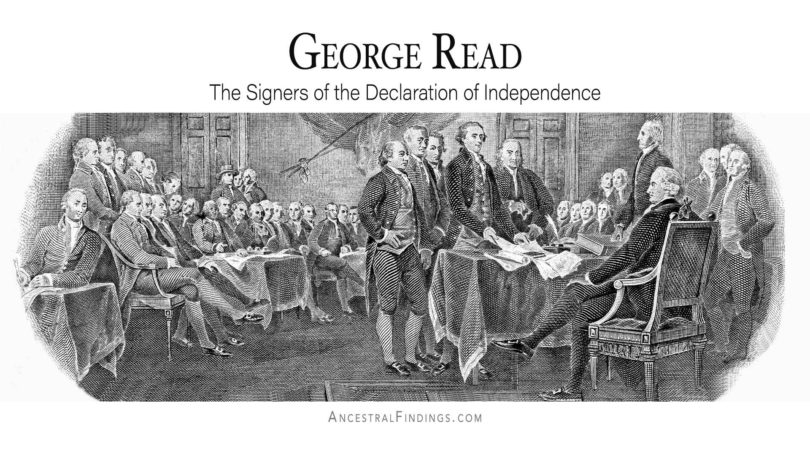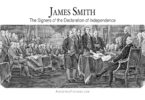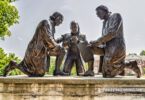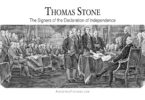George Read was born in September of 1733 in Maryland, then moved with his family to New Castle County, Maryland when he was still a baby. The family settled near the town of Christiana.
George’s parents were John Read and Mary Howell. His dad was born in Dublin, Ireland, and was the son of a wealthy man from the Read family of Berkshire, Hertfordshire, and Oxfordshire in England. George’s dad was in love with a woman in Ireland, and after she crossed over to the other side, leaving him heartbroken, he left Ireland to come to the American colonies to start anew and get his mind off of his sorrow. He entered into business enterprises in Maryland and Delaware, and soon met and married George’s mom.
George attended the Academy of New London, Pennsylvania as a child, joining a future fellow signer, Thomas McKean, as a student there. After the Academy, George studied law in Philadelphia with John Moland. In 1753, he was admitted to the Pennsylvania Bar, then came home to Delaware the next year and opened his own law practice there.
In 1763, George married Gertrude Ross Till, who was the daughter of George Ross. Gertrude’s dad was the rector of the Anglican Immanuel Church in New Castle, Delaware. Her brother, George Ross, was a future signer of the Declaration of Independence. Together, George and Gertrude had four children (John, George, William, and Mary), and lived on The Strand in New Castle. Their house there was in what is now the garden of the Read House and Gardens site, which is a historical attraction owned and operated by the Delaware Historical Society. George and his family were members of the Immanuel Episcopal Church, where Gertrude’s dad was the rector.
George’s dad had been active in the political scene in George’s youth, thanks to the prominent position in the community his success at business enterprises gave him. George followed in those footsteps. As such, he often served as the leader of the Court Party faction in Delaware, which was in favor of the colonies reconciling with Great Britain. This put him in opposition to other prominent Delaware politicians like Caesar Rodney and his friend and former schoolmate Thomas McKean, who were part of the independence-favoring Country Party.
Being in favor of reconciling with Great Britain actually put George in with the majority of people in Delaware at the time. There were things the British did that George didn’t like, such as the Stamp Act, and he was in favor of protests against the British as long as those protests were dignified. Advocating for independence was something he was highly reluctant to do.
Despite these sentiments, George was in charge of the Delaware Committee of Correspondence, a position he was appointed to in 1764. He was also appointed with the more radical Delaware politicians Caesar Rodney and Thomas McKean to be a delegate from Delaware to the First and Second Continental Congresses. Though a member of the Congress from 1774 to 1777, George was often absent from it. When Congress voted on whether to adopt the Declaration of Independence (a vote that had to obtain a unanimous vote from the delegations to be adopted), George surprised everyone there by voting against it. This caused an ill Caesar Rodney to have to ride on horseback overnight from his home in Delaware to Philadelphia to vote in favor of the Declaration in order to break the deadlock on the Delaware delegation (as Thomas McKean had voted in favor of it).
In spite of this, when the Declaration was signed, George put his name on it along with the others, despite him still being personally cautious on the cause of independence.
Once the Declaration was adopted, the Delaware General Assembly decided they should go ahead and declare the colony independent. When they did, they called a constitutional convention to make a state constitution. George was elected to this convention, became its president, and guided the state constitution, which was written by Thomas McKean, through the convention so that it was adopted as the Delaware Constitution.
After this, George was elected to the first Legislative Council of the Delaware General Assembly. On this assembly, George was the speaker of it for two sessions. He served in this position while still serving as a delegate to the Continental Congress. In fact, he became president of the assembly while still on the Continental Congress. This happened because its previous president, John McKinley, was captured by the British. George was on his way home from the Congress when McKinley was captured and narrowly avoided being captured himself. When he went to the Assembly to perform his job there, he found himself elected its new president.
George managed, with some challenges, to keep the Delaware General Assembly, and Delaware itself, safe from British soldiers, though the presence of isolated British raiders near the assembly’s offices forced them to move from New Castle County to Dover, Delaware for its own protection.
After George’s tenure as president of the Assembly was done, he was replaced in that role by Caesar Rodney. George served on the Legislative Council of the Assembly as he had done before his time as president of it. He had to take a year off due to health issues, but went back to it after that, serving several terms on it until the 1777/1778 session. After that session, George worked as a Judge of the Court of Appeals in Cases of Capture, a position to which he had been appointed in 1782. George crossed over to the other side, of heart issues, in September of 1798, and is buried at the cemetery at the church he attended, the Immanuel Episcopal Church. The house in which he and his wife and children lived, called Stonum, is today a historic landmark. There is a school in New Castle that is named for him, as well as a dorm at the University of Delaware.





